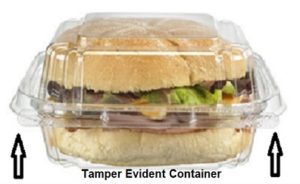 I knew it! I would have sworn on a stack of courtroom Bibles that when people order food for delivery, the drivers sometimes tamper with the food. Even if they do nothing more than peek inside the container, that’s a no-no.
I knew it! I would have sworn on a stack of courtroom Bibles that when people order food for delivery, the drivers sometimes tamper with the food. Even if they do nothing more than peek inside the container, that’s a no-no.
Some recent media outlets and a report broadcast this morning on HLN’s Weekend Express confirmed what I have long suspected and did not need a study by US Foods to reveal. That one in four food delivery drivers, 28 percent, admit to tasting or even taking a bite out of the food before delivering it to the unsuspecting purchaser.
Do you order from a food delivery app? I used a food delivery service only once. That was a couple of years ago. After the driver of UBER eats took an unusually long time to deliver my food, I contacted the eatery from which the food was purchased and learned that the driver had left there 30 minutes earlier. I knew this place well enough to know that it should have taken the driver no more than 15-20 minutes to drive to my home. Shortly after I hung up from talking with the counter clerk, the UBER eats driver called to say that he had gotten lost and would arrive shortly. Really? I thought. (Wide-eye roll.)
I was watching from my window and could see his car when it pulled into the lot. The driver didn’t see me when I first walked outside to retrieve my food. He was too busy talking and laughing with the female passenger seated beside him. Both of them were smoking cigarettes. As soon as he saw me approaching, he hurriedly climbed out of the car and greeted me as did the stench of cigarette smoke following him. He flashed a huge phony smile, opened the rear door, and took out my food that was browned-bagged and sitting on the back seat alongside two others. He handed it to me. Through tight-lips, I mumbled, “Thanks.” Then I tucked the tip folded in my hand, that he would have received, into the pocket of my jeans.
“Never again,” I promised myself as I walked back inside.
I immediately lifted the lid on the Styrofoam container and began inspecting my meal to try and determine if it had been tampered with; of course, I had no way of knowing for sure. What I noticed when lifting the container out of the bag is that the bag reeked of cigarette smoke.
That is the only time I have used a food delivery service. Since my one unpleasant experience with UBER eats, I don’t feel comfortable having ready-to-eat meals delivered. I admit that I periodically order Chinese food from a neighborhood carry out that I have frequented for years. My food is always delivered by one of the employees. Usually, it’s the same friendly older man who has been there for some time.
If you use food delivery apps and have never thought about it before, ask yourself, how would you know if your delivery driver snacked on a few fries or had a sip of your drink on the way to your home? Most likely, you wouldn’t.
NPR.org reports that “When asked if they minded if their driver snagged a few fries, the average customer response was an 8.4 out of 10; one represented ‘no big deal,’ and ten signified ‘absolutely unacceptable.’” As I see it, tasting aside, even opening the container is ABSOLUTELY UNACCEPTABLE!
As restaurant business owners are beginning to understand the problems involved with food delivery, the foodservice industry is working to address these concerns by developing tamper-evident packaging for to-go meals. Some businesses seal takeout containers with a peel-off sticker over the lid or an adhesive that will tear the bag holding the container when opened. Some containers have plastic seals that have to be broken to remove the food and cannot be replaced or resealed once that seal is broken. Tamper-evident does not necessarily mean tamper-proof, but I suppose anything is better than nothing.
In our busy world, everyone is looking for ways to save time and energy. Not having to come home after a busy workday and prepare dinner is certainly one way of doing that. Surely, anytime you don’t feel like cooking, a nice hot pizza delivered to your door is too tempting to refuse. Food delivery is convenient, and it is probably here to stay, but we all know human nature and the nature of some unscrupulous humans is fouler then rotting meat. People must understand the risks and realize that their food could be minus a few bites when it arrives. And if you are inclined to bless your meal, pray that the culprit had clean hands and no disease transmittable through saliva.




